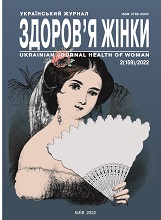Medical and social characteristics of late reproductive age patients with reduced ovarian reserve
DOI:
https://doi.org/10.15574/HW.2022.159.14Keywords:
infertility, older reproductive age, reduced ovarian reserve, assisted reproductive technologies, quality of life, depressionAbstract
Purpose - to determine medical and social features of patients of late reproductive age with reduced ovarian reserve.
Materials and methods. 130 patients with assisted reproductive technologies (ART) programs were divided into groups according to POSEIDON criteria. The main group of 80 patients of older reproductive age (35 years and older) is divided into 2 subgroups according to the POSEIDON criteria. Subgroup 1 consisted of 34 women with a predicted poor response to controlled ovarian stimulation (COS) - group 4 according to POSEIDON. Subgroup 2 - 46 patients with a predicted normal response to COS (POSEIDON group 2). The comparison group consisted of 50 patients under 35 years of age with a predicted normal response to COS (POSEIDON group 1). The quality of life was assessed according to the FertiQoL questionnaire, the presence and degree of depression according to the method of V. Zung.
Results. The share of women aged 40 and older among patients with ART programs with a predicted poor response to COS is 3 times higher than the predicted normal respondents (32.4% vs. 10.9%), which reflects the decisive role of women’s age in reducing ovarian reserve. A significant proportion of women in this category report such a bad habit as smoking (17.6%), the third - a sedentary lifestyle (32.4%) and stress (29.4%), 26.5% - a violation of the daily routine and work. Problems with reproduction affect the quality of life of women and cause psychological changes. More than a third of women (35.3%) rate their health as poor and very poor, and more than half (53.0%) are dissatisfied with their quality of life. The emotional sphere suffers the most from fertility problems (score - 45.3±2.2), and the assessment of mental and physical health and social functioning is reduced. Although patients appreciate the quality of treatment, its tolerability is worse in these women. At the same time, the psychological state of half of women is assessed as subdepressive or masked depression (52.9%), and depression was diagnosed in 14.7% of respondents.
Conclusions. Established medical and social characteristics of women of late reproductive age with reduced ovarian reserve (smoking, daily and work disorders, sedentary lifestyle, stress, low quality of life, subdepressive and depressed state) indicate the need for additional inclusion in ART training programs lifestyle and methods of psychocorrection.
The research was carried out in accordance with the principles of the Helsinki Declaration. The study protocol was approved by the Local Ethics Committee of the participating institution. The informed consent of the patient was obtained for conducting the studies.
No conflict of interests was declared by the authors.
References
Bellver J, Donnez J. (2019). Introduction: Infertility etiology and offspring health. Fertil Steril. 111 (6): 1033-1035. https://doi.org/10.1016/j.fertnstert.2019.04.043; PMid:31155112
Boivin J, Takefman J, Braverman A. (2011). The fertility quality of life (FertiQoL) tool: development and general psychometric properties. Hum Reprod. 26 (8): 2084-2091. https://doi.org/10.1093/humrep/der171; PMid:21665875 PMCid:PMC3137391
Cil AP, Turkgeldi L, Seli E. (2015). Oocyte cryopreservation as a preventive measure for age-related fertility loss. Semin Reprod Med. 33 (6): 429-435. https://doi.org/10.1055/s-0035-1567819; PMid:26562287
Dunstan DA, Scott N. (2019). Clarification of the cut-off score for Zung's self-rating depression scale. BMC Psychiatry. 19 (1): 177. https://doi.org/10.1186/s12888-019-2161-0; PMid:31185948 PMCid:PMC6558728
Grisendi V, Mastellari E, La Marca A. (2019). Ovarian Reserve Markers to Identify Poor Responders in the Context of Poseidon Classification. Front Endocrinol (Lausanne). 10: 281. https://doi.org/10.3389/fendo.2019.00281; PMid:31139145 PMCid:PMC6517840
Haahr T, Esteves SC, Humaidan P. (2018). Individualized controlled ovarian stimulation in expected poor-responders: an update. Reprod Biol Endocrinol. 16 (1): 20. https://doi.org/10.1186/s12958-018-0342-1; PMid:29523204 PMCid:PMC5845159
Nagórska M, Obrzut B, Ulman D, Darmochwał-Kolarz D. (2021). The Need of Personalized Medicine in Coping with Stress during Infertility Treatment. J Pers Med. 11 (1): 56. https://doi.org/10.3390/jpm11010056; PMid:33477431 PMCid:PMC7830688
Parry JP, Koch CA. (2019). Ovarian Reserve Testing. In: Feingold KR, Anawalt B, Boyce A, editors. Endotext. South Dartmouth (MA): MDText.com, Inc: 2000.
Rooney KL, Domar AD. (2018). The relationship between stress and infertility. Dialogues Clin Neurosci. 20 (1): 41-47. https://doi.org/10.31887/DCNS.2018.20.1/klrooney; PMid:29946210 PMCid:PMC6016043
Schmidt L, Sobotka T, Bentzen JG, Nyboe Andersen A, ESHRE Reproduction and Force Society Task. (2012). Demographic and medical consequences of the postponement of parenthood. Hum Reprod Update. 18: 29-43. https://doi.org/10.1093/humupd/dmr040; PMid:21989171
Downloads
Published
Issue
Section
License
Copyright (c) 2022 Ukrainian Journal Health of Woman

This work is licensed under a Creative Commons Attribution-NonCommercial 4.0 International License.
The policy of the Journal UKRAINIAN JOURNAL «HEALTH OF WOMAN» is compatible with the vast majority of funders' of open access and self-archiving policies. The journal provides immediate open access route being convinced that everyone – not only scientists - can benefit from research results, and publishes articles exclusively under open access distribution, with a Creative Commons Attribution-Noncommercial 4.0 international license (СС BY-NC).
Authors transfer the copyright to the Journal UKRAINIAN JOURNAL «HEALTH OF WOMAN» when the manuscript is accepted for publication. Authors declare that this manuscript has not been published nor is under simultaneous consideration for publication elsewhere. After publication, the articles become freely available on-line to the public.
Readers have the right to use, distribute, and reproduce articles in any medium, provided the articles and the journal are properly cited.
The use of published materials for commercial purposes is strongly prohibited.

